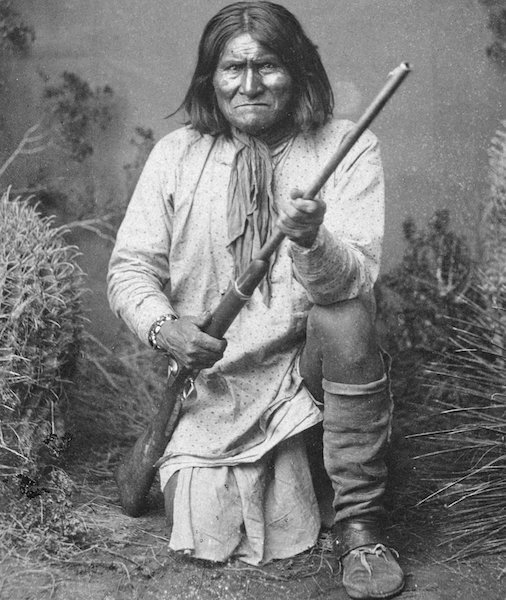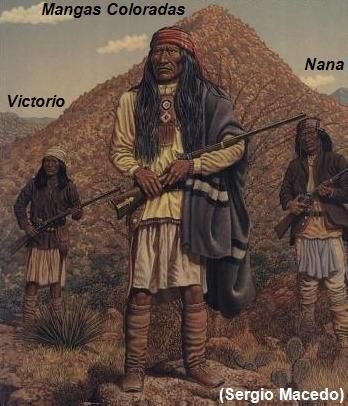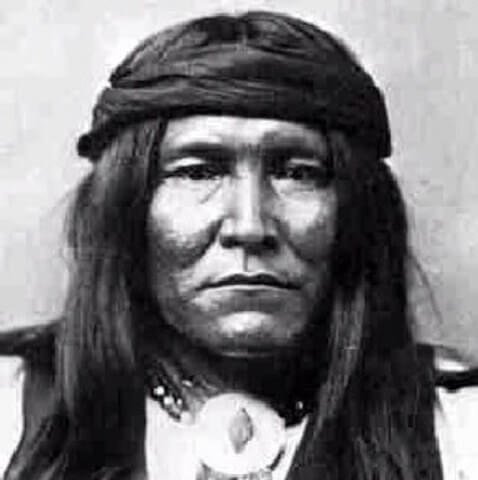[2/4] Geronimo -- Anti-Hero of the SouthWest - Apache Warrior

Source: Wikimedia
Goyathlay - later called "Geronimo"
1887
"In the beginning the world was covered with darkness. There was no sun, no day. The perpetual night had no moon or stars."
Part I
One Who Yawns
His given birth name was Goyathlay ("One Who Yawns"), on June 16, 1829. He was born in Mexican territory, what today would be western New Mexico, and his family belonged to the Be-don-ko-he Tribe, 1 of the 6 Apache Tribes. His parents raised him in the traditional way of the Apache life.
Goyathlay lived the life that generations before him had. His family and tribe gathered, they hunted, and they lived freely off their surroundings, ebbing and flowing with the land and the seasons. The mountains and valleys of what is now the Southwest, on both the American and Mexican side, were his home. There were no International Borders. Here Goyathlay learned how to hunt, fish and use medicinal plants and herbs in the way his ancestors had since the beginning of time. He grew into a young adult having only ever seen people of the Southwest; Pueblo, Navajos, and Apache.
Goyathlay came from a lineage of great warriors. His grandfather, Maco, had been Chief of their tribe until his death. His father had also been a warrior for their tribe, but he died when Goyathlay was very young. So it was a proud moment, when at the age of 17, he was admitted into the Council of Warriors for his tribe, allowing him now to take part in any war parties as well as to marry. He married his first wife, Alope, in 1846 and they had 3 children.
Geronimo!
Since the arrival of the Spanish to the New World in the 1600's, there had been conflict between certain Amerindians and the newly arrived Europeans. These conflicts and wars continued into the 1800's in what would now be Mexico. Treaties had been formed between the Government of Mexico and the Apaches during the Apache-Mexican War. Mexico's new found sovereignty from Spain and the Apaches having many disparate Tribes created a difficult scenario for maintaining peace. One band might have a peace treaty with a town or state in Mexico, while other Apache bands might not. Treaties were constantly broken and re-mended. Then there was also a Comanche front for the Mexican Government to also deal with and it was this confusion that would lead to many atrocities by both Apaches and Mexicans.
On March 5, 1851 Goyathlay died, and Geronimo was born, figuratively. During this great period of confusion, Colonel José María Carrasco of Mexico attacked a village of Apaches that were camping just outside Janos, Mexico. Certain bands of Apaches had been raiding and killing in the states of Sonora and Chihuahua, going against treaties that were in place between the Mexican Government and the Be-don-ko-he band of Apaches. Colonel Carrasco unjustly attacked those in Janos in retaliation, killing Goyathlay's mother, wife and children during the attack. Goyathlay and others had been away trading only to find the massacre upon their return.

Source: Pinterest
Chief Mangas Coloradas
His chief, Mangas Coloradas ordered them to regroup and prepare for a trek back to their home near what is today the New Mexico- Arizona border. Goyathlay mourned all the way there, and in the Apache tradition, burned his mother's teepee, his family's teepee and all their belongings upon his return.
"I was never again contented in our quiet home."
For about one year, the Be-don-ko-he Apache gathered weapons and supplies in preparation for a revenge attack on the Mexicans. When they had what they needed, Mangas Coloradas assigned Goyathlay to go to the other bands of Apaches to ask for their assistance in this war party into Mexico. The Chiricahua and the Nedni along with the Be-don-ko-he, were under the guidance of Goyathlay, who knew the land into Mexico very well. They traveled south into Mexico, what today would be about an hours drive south of the US border, near a town called Arizpe, Sonora, Mexico. Although not a chief, Goyathlay was privileged with generalship of the battle.
The Apaches captured and killed 8 men that had rode out of the town of Arizpe unaware of their presence. This was done to lure out a response from the local military garrison. As planned, the military came out in search of these now dead men, when they were attacked by the Apaches. The Apaches attacked the advancing Mexican Infantry and Cavalry from the front and the rear. Goyathlay led the charge, driven by the blood-thirst of revenge. Many fell by his hand. In the end their stood alone Geronimo, covered in blood over the body of his enemy, screaming the Apache war whoop. There were no Mexican survivors. This day Goyathlay was chosen as War Chief of the Apaches, and nick named Geronimo. As Goyathlay would approach his prey, many in fear would scream begging for mercy, 'Ayudame San Jeronimo' (Save me Saint Jerome!). Geronimo's hatred for Mexicans would last until his last days.
"I could not call back my loved ones, I could not bring back the dead Apaches, but I could rejoice in this revenge."
Unquenched Thirst
The rest of the Apaches had been satisfied with the turn out at Arizpe, Mexico. Geronimo's thirst only grew. After a few months of further preparation, Geronimo convinced two other warriors to accompany him on another raid into Mexico. This time Geronimo luckily returned with his life, alone. Undeterred, Geronimo yet again convinced two more warriors to go on a war party with him. And yet again his attack was thwarted, this time leading to a revenge attack on his village by the Mexicans who killed 3 boys and 2 warriors from his village.
Geronimo again attacked the Mexicans. In this battle they were able to ambush the Mexican Cavalry. The Apaches' surprise attack did not daunt the Mexican troops, and eventually led to close quarter hand to hand fighting. Geronimo slipped on blood and was knocked out cold by the end of a musket. He carried that scar on his forehead for the rest of his life. There was no victory in this battle for they had lost many warriors.
Many in Geronimo's tribe began to turn against him for his incessant desire for revenge against the Mexicans. Nonetheless, he again led another excursion raid into Mexico. Again his attack was thwarted. He again was wounded and had to retreat. His warriors disbanded in their retreat, with the plan to regroup in a designated meeting spot. The warriors needed to retreat fully back to camp. This fruitless raid now led to a revenge attack from the Mexicans. This attack totally devastated the Tribe, leaving them without homes or supplies and winter fast approaching. Geronimo still remained undeterred.
Two Fronts
Geronimo would continue his attacks on Mexican Territory. Geronimo and his tribe would get smarter and disassemble and disband their camp until returning from raiding Mexico. They would make sure that they were not followed, then the Tribe would re-gather to partake of the booty from their mostly successful raids. This would go on for a few years more.
The Mexican-American War ended, and in February 2, 1848, the Treaty of Guadalupe was signed. The peace treaty also came with the purchase of what is now Utah, California, Arizona, New Mexico, Colorado and Wyoming for the United States. Now the Southwest was part of the great American Westward expansion, and many American settlers began to quickly move into these territories. This led to many conflicts with the Native Americans, including the Apache Wars.
Geronimo's first encounters with the American settlers started off rather amicably. The first newcomers were mostly prospectors, scouts and surveyors. They definitely tried to earn the trust of the Native Americans, but as time went on, and more and more newcomers encroached on the Native land, skirmishes would flare. The first major one of these began in the Northwest part of New Mexico in 1849 known as the Jicarilla War between miners and the Jicarilla Tribe. This led to actual U.S. Army encounters in 1853 with Battle of Cieneguilla and Battle of Ojo Caliente Canyon.

Source: Indigenouspeople.net
Chief Cochise of the Chiricahua Apache Tribe
With more encroachments and skirmishes between the Apaches and the American Expansionists, the Apache Chiefs, Mangas Coloradas and Cochise agreed to unite against all encroachments against their lands in 1861. Now they were fighting Mexicans and Americans, with an occasional Comanche skirmish. Chief Mangas was wounded during the Battle of Apache. This would lead to his surrendering, something Geronimo would not do. On January 18, 1863, Mangas Coloradas peacefully surrendered to the U.S. Army, only to then be promptly executed. Since Chief Mangas was about 6' 6" tall, his head was removed and sent to a New York phrenologist.

Source: Wikimedia
Drawing of Skull of Mangas Coloradas from 1873 book "Human Science" p. 1196 by Orson Squire Fowler
Full $teem Ahead!
@streetstyle
My Top Blogs
- Billy the Kid
- $1,500 into $15,000
Sources:
wikipedia.org
indigenouspeople.net
https://www.preceden.com/timelines/49338-geronimo
pinterest.com
http://jodybresch.com/geronimofamily.htm
http://www.let.rug.nl/usa/biographies/geronimo/
http://www.indians.org/welker/geronimo.htm
I smell big Steemit medicine in this post!
We're in Apache country. Lots of history.
Our area was pretty heavily populated, since it's along the Gila. You can walk around the desert here and find where small dwellings once stood. Pottery shards litter the landscape here, with occasional intact ones found. Matates are very common around here too. We have one that was in the yard when we got the house, being used as a downspout catcher.
@anotherjoe The Silver city area is so Beautiful, and Eastern Arizona too. Lucky you!
Interesting post that shows the cruelty of that time. Geronimo, one of the real Americans
I learned that for the Apache, raiding from some of their own member tribes or other nearby Groups of Indians was considered honorable for the Apache. It was part of their way of life. Warfare was not central to their culture, as it might have been in other more warrior like tribes, but they were a very proud people who loved their land, and that is why they battled so fiercely those who came to take it.
full $teem ahead!
Great read
Thanks @otisbrown Appreciate the interest and support.
full $teem ahead!
One of my old heroes.
Another great post!
Yeah Geronimo was a hero to many but he was also unliked by some of his own, I guess that is why I consider him an Anti-Hero. Doesn't take away from any of his greatness, but it just shows that he was human, and had to do some bad stuff to live or let bad stuff happen and die, which we know he did not let the latter happen.
full $teem ahead!